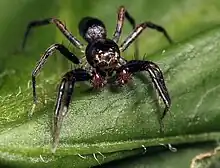| Asemonea virgea | |
|---|---|
 | |
| A spider of the Asemonea genus | |
| Scientific classification | |
| Domain: | Eukaryota |
| Kingdom: | Animalia |
| Phylum: | Arthropoda |
| Subphylum: | Chelicerata |
| Class: | Arachnida |
| Order: | Araneae |
| Infraorder: | Araneomorphae |
| Family: | Salticidae |
| Genus: | Asemonea |
| Species: | A. virgea |
| Binomial name | |
| Asemonea virgea Wesołowska & Szűts, 2003 | |
Asemonea virgea is a species of jumping spider in the genus Asemonea that is endemic to the Republic of the Congo. The spider was first described in 2003 by Wanda Wesołowska and Tamás Szűts. The spider is small, with a dark yellow carapace typically 1.6 mm (0.063 in) long and an abdomen 1.8 mm (0.071 in) long. The male has a distinctive set of spines on its palpal tibia, after which it is named. It is similar to the related Asemonea cristata but differs in its species range, as the other spider is found in Burma, and its shorter femoral apophysis. The female has not been described.
Taxonomy
Asemonea virgea is a jumping spider first described by Wanda Wesołowska and Tamás Szűts in 2003.[1] It is one of over 500 species identified by the Polish arachnologist Wesołowska.[2] The species was allocated to the genus Asemonea, first raised by Octavius Pickard-Cambridge in 1869.[3] The genus is related to Lyssomanes, but the relationship is uncertain.[4][5] Molecular analysis demonstrates that the genus is similar to Goleba and Pandisus.[6] In Wayne Maddison's 2015 study of spider phylogenetic classification, the genus Asemonea was the type genus for the subfamily Asemoneinae.[7] A year later, in 2016, Jerzy Prószyński named it as the type genus for the Asemoneines group of genera, which was also named after the genus.[8] The species itself has a name that is derived from the Latin for rod and recalls the spines on the palpal tibia.[9]
Description
The spider is small. The male has a moderately high pear-shaped carapace that is typically 1.6 mm (0.063 in) long and 1.2 mm (0.047 in) wide. It is dark yellow with a thin brown line around the edge. It has a slightly lighter eye field with the eyes arranged in four rows. The clypeus is whiteish. The chelicerae are orange, with five small teeth visible on the edge. The abdomen is an oval that is typically 1.8 mm (0.071 in) long and 1.0 mm (0.039 in) wide. It is pale yellow with a brownish band across the edge, small dark dots towards the sides and two arrow-shaped dark patches on the top. The underside is whiteish. The spider has long spinnerets and long thin legs, all generally whiteish-yellow. The pedipalps are light brown. There is a long furrow on the palpal femur and a femoral apophysis with a pointed end. The retrolateral tibial apophysis is large and shaped like an anvil.[9] There are three rod-like spines on the top of the palpal bulb.[10] The female has not been described.[1]
The spider most resembles Asemonea cristata, found in Burma.[11] It can be distinguished by its shorter femoral apophysis.[9]
Behaviour
The spider is typical of the genus.[9] Asemonea spiders rarely jump. Instead, they generally walk and run. The y spin sheet webs on the underside of leaves, where they also lay their eggs.[12] Although predominantly a diurnal hunter, the spider is also likely to eat nectar if it is available.[13][14]
Distribution and habitat
The species is endemic to the Republic of the Congo.[1] The holotype was found near Brazzaville in 1963. The spiders thrive in trees and shrubs.[11]
References
Citations
- 1 2 3 World Spider Catalog (2017). "Asemonea virgea Wesolowska & Szűts, 2003". World Spider Catalog. 18.0. Bern: Natural History Museum. Retrieved 13 May 2017.
- ↑ Wiśniewski 2020, p. 6.
- ↑ Wesołowska & Szűts 2003, p. 55.
- ↑ Jackson 1990, p. 1.
- ↑ Wanless 1980, p. 217.
- ↑ Maddison 2015, p. 236.
- ↑ Maddison 2015, p. 235.
- ↑ Prószyński 2017, p. 122.
- 1 2 3 4 Wesołowska & Szűts 2003, p. 56.
- ↑ Wesołowska & Szűts 2003, p. 57.
- 1 2 Wesołowska & Szűts 2003, p. 58.
- ↑ Jackson 1990, p. 2.
- ↑ Richman & Jackson 1992, p. 33.
- ↑ Jackson et al. 2001, p. 28.
Bibliography
- Jackson, Robert R. (1990). "Comparative study of lyssomanine jumping spiders (Araneae: Salticidae): Silk use and predatory behaviour of Asemonea, Goleba, Lyssomanes, and Onomastus". New Zealand Journal of Zoology. 17 (1): 1–6. doi:10.1080/03014223.1990.1042257.
- Jackson, Robert R.; Pollard, Simon D.; Nelson, Ximena J.; Edwards, G. B.; Barrion, Alberto T. (2001). "Jumping spiders (Araneae: Salticidae) that feed on nectar". Journal of Zoology. 255 (1): 25–29. doi:10.1017/S095283690100108X.
- Maddison, Wayne P. (2015). "A phylogenetic classification of jumping spiders (Araneae: Salticidae)". The Journal of Arachnology. 43 (3): 231–292. doi:10.1636/arac-43-03-231-292. S2CID 85680279.
- Prószyński, Jerzy (2017). "Pragmatic classification of the World's Salticidae (Araneae)". Ecologica Montenegrina. 12: 1–133. doi:10.37828/em.2017.12.1.
- Richman, David B.; Jackson, Robert R. (1992). "A review of the ethology of jumping spiders (Araneae, Salticidae)". Bulletin of the British Arachnology Society. 9 (2): 33–37.
- Wanless, Fred R. (1980). "A revision of the spider genera Asemonea and Pandisus (Araneae: Salticidae)". Bulletin of the British Museum of Natural History (Zoology). 39: 213–257. doi:10.5962/bhl.part.13273.
- Wesołowska, Wanda; Szűts, Tamás (2003). "A new species of Asemonea from equatorial Africa (Araneae: Salticidae: Lyssomininae)" (PDF). Folia Entomologica Hungarica. 64: 59–62. Retrieved 13 May 2017.
- Wiśniewski, Konrad (2020). "Over 40 years with jumping spiders: on the 70th birthday of Wanda Wesołowska". Zootaxa. 4899 (1): 5–14. doi:10.11646/zootaxa.4899.1.3. PMID 33756825. S2CID 232337200.